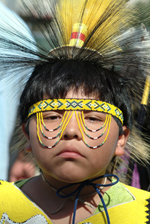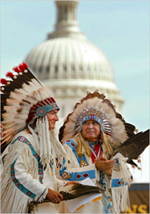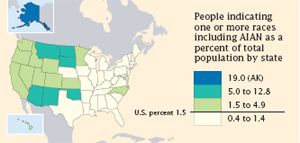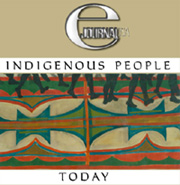 |
| Dressed up for the Festivities at the Opening Event of the National Museum of the American Indian. ( Photos by Lloyd Wolf for the U.S. Census Bureau) |
The first American immigrants, beginning more than 20,000 years ago, were intercontinental wanderers: hunters and their families following animal herds from Asia to America, across a land bridge where the Bering Strait is today. When Spain's Christopher Columbus "discovered" the New World in 1492, about 1.5 million Native Americans lived in what is now the continental United States, although estimates of the number vary greatly. Mistaking the place where he landed -- San Salvador in the Bahamas -- for the Indies, Columbus called the Native Americans "Indians."
During the next 200 years, people from several European countries followed Columbus across the Atlantic Ocean to explore America and set up trading posts and colonies. Native Americans suffered greatly from the influx of Europeans. The transfer of land from Indian to European -- and later American -- hands was accomplished through treaties, wars, and coercion, with Indians constantly giving way as the newcomers moved west. In the 19th century, the government's preferred solution to the Indian "problem" was to force tribes to inhabit specific plots of land called reservations. Some tribes fought to keep from giving up land they had traditionally used. In many cases the reservation land was of poor quality, and Indians came to depend on government assistance. Poverty and joblessness among Native Americans still exist today.
The territorial wars, along with Old World diseases to which Indians had no built-up immunity, sent their population plummeting, to a low of 350,000 in 1920. Some tribes disappeared altogether; among them were the Mandans of North Dakota, who had helped Meriwether Lewis and William Clark in exploring America's unsettled northwestern wilderness in 1804-06. Other tribes lost their languages and most of their culture. Nonetheless, Native Americans have proved to be resilient. Today they number 4.5 million (about 1.5 percent of the total U.S. population), and only about one-third of Native Americans still live on reservations.
Countless American place-names derive from Indian words, including the states of Massachusetts, Ohio, Michigan, Mississippi, Missouri, and Idaho. Indians taught Europeans how to cultivate crops that are now staples throughout the world: corn, tomatoes, potatoes, tobacco. Canoes, snowshoes, and moccasins are among the Indians' many inventions.
|
|
Indigenous
People in the 21st Century
Wilma Mankiller. eJournal, June 2009.
Being an indigenous person in modern times means balancing revered traditions,
culture, and languages with the demands of a world dominated by technology.
Mankiller is former chief of the Cherokee Nation.
Living
Traditions of Native America
Gabrielle Tayac. eJournal, June 2009
Coming to terms with a rich and ancient tradition, years of struggle
and discrimination, and life in modern times, Native peoples must juggle
the valuable old with the new. Historian Tayac is of Piscataway descent.
U.S.
Honors Contributions of American Indians, Alaska Natives
America.gov, November 3, 2008.
Each November, National American Indian Heritage Month pays tribute
to the legacy of the American Indians and Alaska Natives — the
first Americans — and celebrates their enduring contributions
to the history and culture of the United States.
Today,
there are nearly 5 million American Indians and Alaska Natives in the
United States, or 1.6 percent of the total population, and this is expected
to jump to 8.6 million, or 2 percent of the population, by 2050.
Most
American Indians live in metropolitan areas and not on the 227,000 square
kilometers of land held in trust for reservations. The states with the
highest percentage of American Indians and Alaska Natives are Alaska
(18 percent of its population), Oklahoma (11 percent) and New Mexico
(10 percent).
There
are 562 federally recognized Indian tribes in the United States. The
largest, by far, are the Cherokee and Navajo nations, according to the
2000 U.S. census....
Navajo
Textbook Aims to Preserve Language, Culture
New Mexico is first state to approve Native American language text.
By Jeffrey Thomas. America.gov, August 5, 2008.
In many countries with indigenous populations, how these groups adapt
to the modern world while protecting their own cultures is an important
question. It therefore was reported widely when New Mexico in July became
the first U.S. state to approve a textbook that teaches a Native American
language -- Diné Bizaad Bínáhoo'aah or Rediscovering
the Navajo Language. Native North American languages are spoken by about
380,000 Americans, according to the 2000 census. The Navajo Nation numbers
almost 300,000 people, of whom about 178,000 speak the Navajo language,
making it the most widely spoken Native American language....
American Indians Seek Greater Understanding, Recognition
By Jeffrey Thomas, America.gov, October 18, 2007.
“Maybe you should just tell them that we still exist,” an American Indian told the moderator of a focus group during a recent study that not only has highlighted continuing misconceptions about American Indians, but also has revealed the sympathy with which many Americans view Indians’ history and desire to learn more about their past and present...
National Powwow Honors American Indian Cultural Traditions
By Lauren Monsen, America.gov, August 14, 2007.
Since the late 19th century, powwows have been a significant social and cultural force in the lives of the indigenous people of North America. Bringing together American Indians from different tribes to dance, sing and share traditions, these social events are held throughout the United States from March to September, but the largest on the East Coast is the National Powwow, a biennial event in Washington that attracts members of some 250 tribal nations from the United States and Canada...
 |
Senator Ben Nighthorse Campbell, right, a Northern Cheyenne Indian, applauds W. Richard West Jr., a Southern Cheyenne, who is the director of the new National Museum of the American Indian, at the dedication ceremonies for the museum on the National Mall in Washington, September 21, 2004. (© AP Images) |
United States Respects Indian Tribes' Right to Self-Determination
Indian tribes retain unique sovereign status as "domestic dependent nations". By Peggy B. Hu and Jeffrey Thomas. America. gov, November 6, 2006.
Many people are puzzled when they hear the U.S. president use such phrases as “government-to-government basis with tribal governments,” “tribal sovereignty” or “self-determination” for American Indians. Isn’t the United States “one nation ... indivisible," as the Pledge of Allegiance says?
The answer is more interesting than a simple “yes” or “no.” According to the U.S. Department of Justice's Office of Tribal Justice, American Indian tribes are considered "domestic dependent nations" within the United States. As such, they retain sovereign powers over their members and territory except where such powers specifically have been modified by U.S. law. American Indians are more than members of a racial minority group in the United States; they are indigenous people of the Americas with a status akin to dual citizenship.
Laws Reflect Changing Status of American Indians in U.S. History. America.gov, November 6, 2006
The history of U.S. legislation regarding American Indians reveals changing societal attitudes on their status -- from members of fully sovereign nations, to dependents of the U.S. government, to holders of a quasi dual-citizenship.
|





